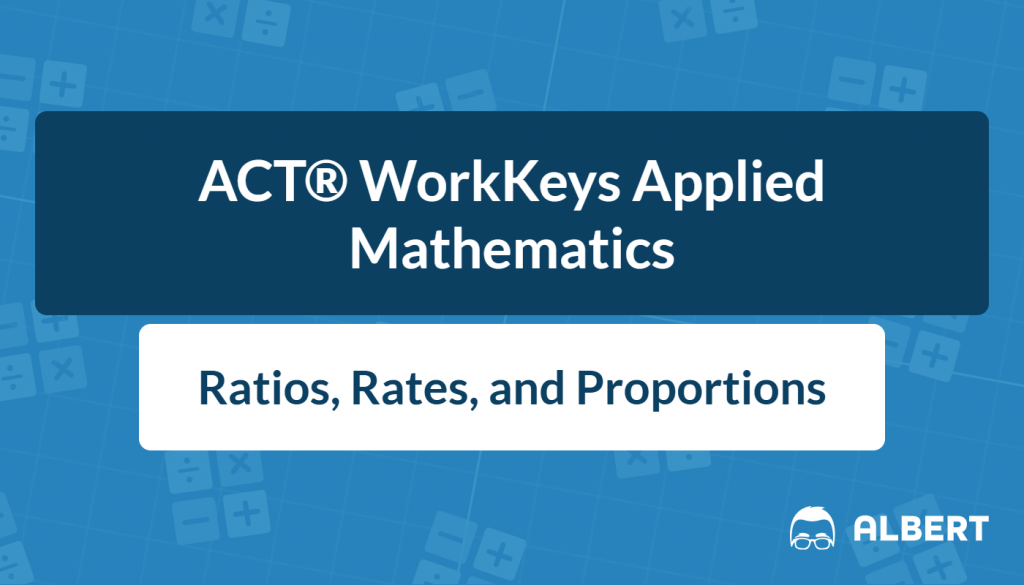Math concepts like ratios, proportions, and rates can be challenging, especially for students preparing for tests like the ACT® WorkKeys Applied Math Test. However, these concepts are essential in school and daily life, such as adjusting recipe ingredients or comparing prices while shopping.
In this article, we will clarify ratios, proportions, and rates. We will explain their meanings, how they are related, and their practical applications. With clear examples and simple steps, you’ll see how these concepts are relevant for tests and everyday decisions.
What We Review
What Are Ratios?
A ratio compares two amounts and shows how many times one quantity fits into another. It helps us understand the relationship between numbers. For example, if there are 2 apples and 3 oranges in a fruit basket, the ratio of apples to oranges is 2:3. We can write this ratio in three ways: 2:3, 2/3, or “2 to 3.”
Ratios in Everyday Life
Ratios are found all around us! You’ll notice them in cooking recipes requiring exact quantities of ingredients. They’re also present on maps, where scales are displayed as ratios. For example, when making lemonade with a 1:4 ratio, use one cup of lemon juice for every four cups of water.
What Are Proportions?
Proportions take the concept of ratios one step further. A proportion is an equation that states that two ratios are equal. For instance, if we say that 1/2 is equal to 2/4, we’re using proportions to show that these two fractions represent the same relationship.
Solving Proportions

To solve proportions, our main goal is to find the unknown number that makes the equation true. Let’s look at an example: the proportion 3/4 = x/8.
To find x, we can use a method called cross-multiplication. This means we multiply the top number of one fraction by the bottom number of the other fraction. Here, if we multiply 3 by 8, we get 24. At the same time, we multiply 4 by x, which gives us 4x.
Now we have the equation: 24 = 4x. To find x, we divide both sides by 4. This shows us that x equals 6.
By following these steps, we can easily find the missing number in the proportion.
Real-World Applications
Proportions are essential tools for adjusting quantities in a recipe when you need to scale up or down. For instance, if you’re planning a party and have a recipe that serves 4 people, but you want to modify it to feed 12 guests, you can use proportions to find the right ingredient amounts.
To do this, first, determine the scaling factor: since 12 divided by 4 equals 3, you’ll need to triple each ingredient quantity. For example, if the original recipe calls for 1 cup of flour, you’ll need 3 cups for the larger group.
Understanding Rates
A rate is a specific type of ratio in which the two quantities being compared have different units. For instance, if you drive 60 miles in 2 hours, your rate of speed calculates to 30 miles per hour. Time is a common element in many rates and can be measured in seconds, minutes, or hours. For example, if a runner completes a 5K race in 25 minutes, their pace would be 5 minutes per kilometer. Similarly, if you pay $12 for 3 hours of parking, the rate comes to $4 per hour. This concept revolves around comparing various types of quantities, such as distance over time, cost per item, and time spent per task.
Rates in the Real World
These principles are extremely useful in everyday situations, particularly when making informed decisions about time and money management.
Imagine you are considering two options for getting your car washed. The first car wash charges $10 and takes 15 minutes to complete, while the second car wash charges $12 but has a quicker turnaround of just 8 minutes. To determine which option provides better value for your time, you can calculate the cost per minute for each service.
For the first car wash, you divide the total cost of $10 by the 15 minutes it takes, resulting in a rate of approximately $0.67 per minute. In contrast, for the second car wash, you divide the $12 fee by the 8 minutes required, yielding a rate of $1.50 per minute.
By comparing these rates, you can see that the first car wash offers a better value in terms of cost per minute spent. This process helps you save money and improves your ability to make more strategic time-based decisions in the future.
How to Approach ACT® WorkKeys Applied Math Problems
The ACT® WorkKeys Applied Math Test can include questions on ratios, proportions, and rates. Here’s a step-by-step approach to tackle these problems:
Step 1: Understand the Problem
Read the question carefully to grasp what is being asked. As you do this, it can be helpful to write down the information that is given and what you’re trying to determine. Additionally, identify whether you’re dealing with a ratio, proportion, or rate. This will provide clarity and structure to your approach as you work towards a solution.
Step 2: Set Up the Equation
When dealing with ratios, write down the relationship between the two quantities you are comparing. Make sure to clearly define each part of the ratio and how they relate. If you’re tackling proportions, set up the equation using the known values you gathered in Step 1. This may involve writing a fraction that represents the relationship between two ratios. For rates, it’s essential to verify that you are comparing the correct units, whether that means distance over time, cost per item, or another type of quantity.
Step 3: Solve the Equation
Now that your equation is set up, use basic algebraic principles to solve for the unknown variable. This might involve cross-multiplication when working with proportions, where you multiply the numerator of one fraction by the denominator of the other to find the missing value. If the problem involves rates, ensure you convert units as necessary to maintain consistency within the equation. For example, if you’re calculating speed in miles per hour, ensure that distances are in miles and time is in hours.
Step 4: Check Your Work
Lastly, go back and double-check your calculations to ensure they make sense in the context of the problem. Review each step to confirm that you applied the appropriate mathematical principles correctly. Consider whether your answer is reasonable given the situation; for example, if a rate seems unreasonably high or low, it may indicate an error in your calculations.
Practice Questions
Let’s put what we’ve learned into practice with some sample questions.
Question 1: Ratios
A recipe calls for a 2:3 ratio of sugar to flour. If you have 8 cups of flour, how much sugar do you need?
Solution: Set up the equation \frac{2}{3} = \frac{x}{8} . Cross-multiply to get 2 \cdot 8 = 3 \cdot x , which simplifies to 16 = 3x . Divide both sides by 3 to find x = 5.33 . You need approximately 5.33 cups of sugar.
Question 2: Proportions
You have a map with a scale of 1 inch representing 5 miles. If the distance between two cities on the map is 7 inches, what is the actual distance?
Solution: Set up the proportion \frac{1}{5} = \frac{7}{x} . Cross-multiply to get 1 \cdot x = 5 \cdot 7 , which simplifies to x = 35 . The actual distance is 35 miles.
Question 3: Rates
If your car consumes 10 gallons of fuel to travel 250 miles, what is the fuel consumption rate in miles per gallon?
Solution: Divide the miles traveled by the gallons used: \frac{250 \, \text{miles}}{10 \, \text{gallons}} = 25 \, \text{miles per gallon} .
Conclusion: Ratios, Rates, and Proportions
Ratios, proportions, and rates are important ideas you use daily. By learning and practicing these concepts, you will be better prepared for tests like the ACT® WorkKeys Applied Math Test. You will also improve your skills in solving daily problems. Keep practicing your math skills, as practice helps you get better!
Sharpen Your Skills for ACT® WorkKeys Applied Math
Are you preparing for the ACT® WorkKeys Applied Math test? We’ve got you covered! Try our review articles designed to help you confidently tackle real-world math problems. You’ll find everything you need to succeed, from quick tips to detailed strategies. Start exploring now!
- Multiplying Fractions: Simple Strategies for Quick Solutions
- Dividing Fractions: An Easy Guide to Get It Right Every Time
Need help preparing for the ACT® WorkKeys Applied Math Test?
Albert has hundreds of ACT® WorkKeys practice questions and full-length practice tests to try out.








